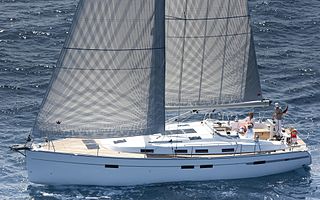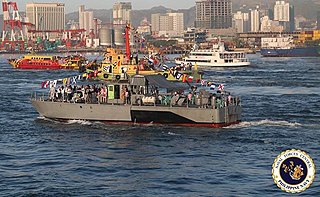Related Research Articles

A yacht is a sailing or power vessel used for pleasure, cruising, or racing. There is no standard definition, though the term generally applies to vessels with a cabin intended for overnight use. To be termed a yacht, as opposed to a boat, such a pleasure vessel is likely to be at least 33 feet (10 m) in length and may have been judged to have good aesthetic qualities.

The Long Range Interceptor (LRI) is an 11-meter high speed launch vessel designed to be deployed from United States Coast Guard cutters via a rear launching ramp. The Long Range Interceptor is an aluminum boat, powered by Ultrajet brand water-jets, for intercepting and boarding suspect vessels. It mounts a radar, special shock-proof seats, and can travel at 35 knots (65 km/h). They can be armed with machine guns or grenade launchers, and can be equipped with ballistic panels for crew protection when required.

The Defender-class boat, also called Response Boat – Small (RB-S) and Response Boat – Homeland Security (RB-HS), is a standard boat introduced by the United States Coast Guard in 2002. The boats serve a variety of missions, including search and rescue, port security and law enforcement duties and replaces a variety of smaller non-standard boats.

The Point-class cutter was a class of 82-foot patrol vessels designed to replace the United States Coast Guard's aging 83-foot wooden hull patrol boat being used at the time. The design utilized a mild steel hull and an aluminum superstructure. The Coast Guard Yard discontinued building the 95-foot Cape-class cutter to have the capacity to produce the 82-foot Point-class patrol boat in 1960. They served as patrol vessels used in law enforcement and search and rescue along the coasts of the United States and the Caribbean. They also served in Vietnam during the Vietnam War. They were replaced by the 87-foot Marine Protector-class coastal patrol boats beginning in the late 1990s.
A rescue lifeboat is a boat rescue craft which is used to attend a vessel in distress, or its survivors, to rescue crew and passengers. It can be hand pulled, sail powered or powered by an engine. Lifeboats may be rigid, inflatable or rigid-inflatable combination-hulled vessels.

The Canadian Coast Guard (CCG) maintains a fleet of 14.6 m Cape-class motor lifeboats based on a motor lifeboat design used by the United States Coast Guard. In September 2009 the CCG announced plans to add five new lifeboats, bringing the total number of Cape-class lifeboats to 36.

Yard Patrol craft are used by the United States Navy for training and for research purposes. They are designated as YP in the hull classification symbol system. They were nicknamed "Yippy boats" after the "YP" classification symbol.

ABG fast interceptor craft are a series of thirteen 26-metre (85 ft) high-speed interceptor boats designed and supplied in knocked down kits by Henderson based Global Marine Design and assembled by ABG Shipyard, Surat for the Indian Coast Guard.

The BRP Alfredo Peckson (PC-372) is the third ship of the Jose Andrada class coastal patrol boats of the Philippine Navy. It is part of the first batch of its class ordered through US Foreign Military Sales (FMS) in 1989, and was commissioned with the Philippine Navy on 24 June 1991. It was initially designated as Fast Patrol Craft, and was numbered "DF-372", but later on was re-designated as a Patrol Gunboat, and was re-numbered as "PG-372", until another round of reclassification changed its designation as a Patrol Craft with hull number "PC-372" from April 2016.

USCGC Anacapa (WPB-1335) is an Island-class cutter of the United States Coast Guard. She is based at Petersburg, Alaska and is responsible for law enforcement, search and rescue, and maritime defense.
The Tara Bai class of coastal patrol vessels is a series of six watercraft built by Singapore Slipway & Engineering and Garden Reach Shipbuilders & Engineers, Kolkata for Indian Coast Guard. They are intended for search and rescue, fisheries patrol and sovereignty patrol.
AMPL (P-2000) class of interceptor boats are series of ten watercraft built by M/s Anderson Marine Private Limited, Goa, India for the Indian Coast Guard.
Mandovani Marine (12.5-Meter) class of patrol crafts are a series of five watercraft built by Mandovi Marine Pvt LTD, Indore for Indian Coast Guard during the 1980s .
The Bristol class of interceptor craft are a series of watercraft built by Bristol Boats, a division of Chika Pvt. Ltd Aroor, for the Indian Coast Guard. These boats are intended for carrying out patrol duties in shallow water areas near the coastline. The contract was signed on 22 March 2004 for acquisition of eight Interceptor Boats by the Indian Coast Guard at a total cost of Rs 3.74 crores. The first craft became operational on 1 December 2004.
Mandovi Marine patrol crafts are 15 metre long patrol crafts with glass reinforced plastic hull built by Mandovi Marine Pvt LTD, Indore, India.
Praga Marine Pvt. Ltd. is a fiberglass boat manufacturing company. It owns a boatyard, located in the backwaters of Cochin at Aroor Industrial Development Area, Allappuzha District It was incorporated in 1985 and commenced business from that boatyard in 1988. It is promoted by Joe Nejedly. His father Josef Nejedly, a Prague-born Czech national was a pioneer of the fibre glass industry in India during the 1960s.
GRSE Mauritius offshore patrol vessel (MOPV) is a corvette being built by Garden Reach Shipbuilders and Engineers (GRSE), Kolkata, for the National Coast Guard of Mauritius.

USCGC Liberty (WPB-1334) is an Island-class cutter of the United States Coast Guard. She spent her first 33 years of service homeported in Juneau, Alaska where she patrolled territorial waters, including the Inside Passage. In 2016 she won the Hopley Yeaton Cutter Excellence Award for outstanding operational and humanitarian achievements. In 2022 she was reassigned to Valdez, Alaska.

Crash boats, at the time known as "aircraft rescue boats" or "air-sea rescue boats", were wooden speedboats built to rescue the crew of downed United States and other Allies aircraft during World War II. US boats came from observation of British experience with high-speed launches during the Battle of Britain.

Splinter fleet or Splinter navy was a nickname given to the United States wooden boats used in World War II. The boats served in many different roles during the war. These boats were built in small boatyards on the West coast and East coast, Great Lakes and the Gulf of Mexico. They could be built quickly, in just 60 to 120 days. Most of the boats were built by boatyards that already had the tools and knowledge from building yachts, sailboats and motor boats. Many were built by craftsmen in family-owned small businesses. Under the Emergency Shipbuilding Program and War Shipping Administration contracts went out to over fifty boatyards across the country. The boats were built for the US Navy, the, United States Army Air Forces, United States Coast Guard, and US Army. Some of the wooden boats went to Allied nations on the Lend-Lease program.